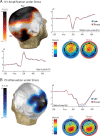Stress potentiates early and attenuates late stages of visual processing
- PMID: 21248140
- PMCID: PMC3037336
- DOI: 10.1523/JNEUROSCI.3384-10.2011
Stress potentiates early and attenuates late stages of visual processing
Abstract
Stress can fundamentally alter neural responses to incoming information. Recent research suggests that stress and anxiety shift the balance of attention away from a task-directed mode, governed by prefrontal cortex, to a sensory-vigilance mode, governed by the amygdala and other threat-sensitive regions. A key untested prediction of this framework is that stress exerts dissociable effects on different stages of information processing. This study exploited the temporal resolution afforded by event-related potentials to disentangle the impact of stress on vigilance, indexed by early perceptual activity, from its impact on task-directed cognition, indexed by later postperceptual activity in humans. Results indicated that threat of shock amplified stress, measured using retrospective ratings and concurrent facial electromyography. Stress also double-dissociated early sensory-specific processing from later task-directed processing of emotionally neutral stimuli: stress amplified N1 (184-236 ms) and attenuated P3 (316-488 ms) activity. This demonstrates that stress can have strikingly different consequences at different processing stages. Consistent with recent suggestions, stress amplified earlier extrastriate activity in a manner consistent with vigilance for threat (N1), but disrupted later activity associated with the evaluation of task-relevant information (P3). These results provide a novel basis for understanding how stress can modulate information processing in everyday life and stress-sensitive disorders.
Figures



References
-
- Arnsten AF. The biology of being frazzled. Science. 1998;280:1711–1712. - PubMed
-
- Arnsten AF, Goldman-Rakic PS. Noise stress impairs prefrontal cortical cognitive function in monkeys: evidence for a hyperdopaminergic mechanism. Arch Gen Psychiatry. 1998;55:362–368. - PubMed
-
- Bishop SJ. Neurocognitive mechanisms of anxiety: an integrative account. Trends Cogn Sci. 2007;11:307–316. - PubMed
Publication types
MeSH terms
Grants and funding
- R37-MH43454/MH/NIMH NIH HHS/United States
- P30 HD003352/HD/NICHD NIH HHS/United States
- F31 MH070110/MH/NIMH NIH HHS/United States
- T32-HD007151/HD/NICHD NIH HHS/United States
- T32 MH018931/MH/NIMH NIH HHS/United States
- R01 MH043454/MH/NIMH NIH HHS/United States
- R37 MH043454/MH/NIMH NIH HHS/United States
- P50-MH52354/MH/NIMH NIH HHS/United States
- P50 MH052354/MH/NIMH NIH HHS/United States
- T32 HD007151/HD/NICHD NIH HHS/United States
- T32-MH18931/MH/NIMH NIH HHS/United States
- P50 MH069315/MH/NIMH NIH HHS/United States
- F31-MH070110/MH/NIMH NIH HHS/United States
LinkOut - more resources
Full Text Sources
Medical
